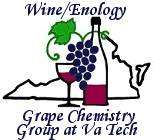
Enology Notes
Wine/Enology Notes # 86 March 2, 2004
To: Regional Wine Producers
From: Bruce Zoecklein, Head, Wine/Enology-Grape Group, Virginia Tech.
Subjects: Winery Planning and Design Workshop, Gum Arabic
Winery Planning and Design Workshop. A one-day Winery Planning and Design Workshop is scheduled for June 6, 2004, at Penn State, College Park, PA. This program is for those seriously interested in entering the commercial wine industry.
This event is being coordinated by Dr. Bruce Zoecklein, Head, Enology-Grape Chemistry Group, Virginia Tech, and Dr. Stephen Menke, Enology Extension Educator, Penn State, and is co-sponsored by Virginia Tech and Penn State.
The workshop will include presentations, discussions, and printed materials on the following:
- The components of a successful business plan
- The economics of table wine production
- Winery design
- Design areas:
- raw production handling
- fermentation
- barrel fermentation/storage
- warehousing
- lab
- bottling
- tourism/administration
- Equipment
- Refrigeration, temperature control, ventilation
- Sanitation, steam and hot water requirements
- Lighting
- Electrical requirements
- Water and waste water requirements
- Gravity flow considerations
- Caves
- Expansion considerations
- Design areas:
- Government compliance issues
The workshop fee is $300, payable to Penn State. Send check to
Mid-Atlantic Winery Planning and Design Workshop
c/o Stephen Menke,
Adams County Extension Office,
670 Old Harrisburg Road,
Gettysburg, PA., 17325-3404
Pre-registration is required and enrollment capacity is limited. The registration deadline is May 21, 2004.
Additional registration information is available from Terry Rakestraw at 540-231-6805.
Additional program information is available from Dr. Bruce Zoecklein, Head, Enology-Grape Chemistry Group, Virginia Tech, at bzoeckle@vt.edu or phone (540) 231-5325 and posted on the group's website at www.vtwines.info. From the home page, click on events.
Gum Arabic. Gum Arabic is a naturally occurring gum derived from the Acacia tree. It has been widely used in the food and pharmaceuticals industry. There are several products which are being marketed for the wine industry. Gums produced from different botanical origins can have different properties, which can influence winemaking applications. Specialty products are available for white vs. red wines, and for specific applications.
The major application of Gum Arabic has been in the stabilization of red wine color in young wines, by acting as a protective colloid. This aids in preventing pigment precipitation. Gum Arabic also has other sensory impacts that include nose, palate and mouthfeel modifications.
Gum Arabic can impact mouthfeel by imparting palate softness. As discussed in the previous edition, the balance of wine structure and textural elements interact. Gums can reduce tannin astringency. As such, they can increase the perception of body or volume, reduce the perceptions of acidity and tannin harshness, while adding body (see Enology Notes #84 and #85).
Like all refining agents, the use of Gum Arabics must be carefully reviewed via fining trials. The addition of such products must occur post-filtration, just prior to bottling. Because of the nature of gums, filtration would both eliminate their colloidal impact and plug filters.
This discussion of Gum Arabic is designed to inform, and should not be taken as a recommendation for use.
![]()
Subscription to Enology Notes. All past Enology Notes newsjournals are posted on the Enology-Grape Chemistry Group's web site at: http://www.vtwines.info/. Enology Notes are slightly different in content from the subscription based Vintner's Corner newsjournal.
To be added to (or removed from) the Enology Notes listserve send an email message to with the word "ADD" or "REMOVE" in the subject line.
Dr. Bruce
Zoecklein
Professor and Enology Specialist Head Enology-Grape Chemistry Group
Department of Food Science and Technology, Virginia Tech
Blacksburg VA 24061
Enology-Grape Chemistry Group Web address: http://www.vtwines.info/
Phone: (540) 231-5325
Fax: (540) 231-9293
Email: